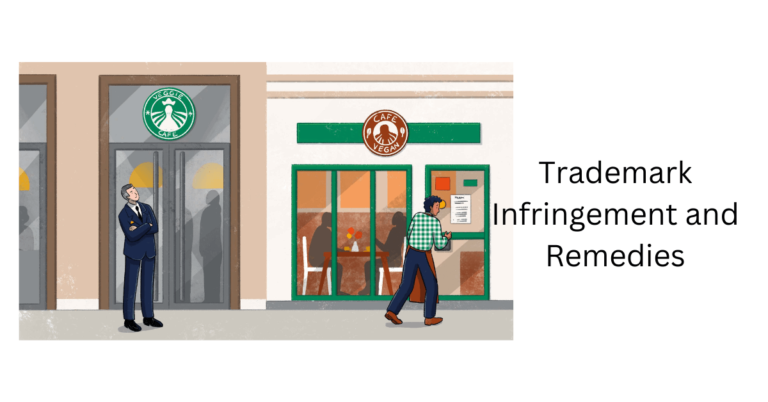A trademark represents the goodwill and reputation of a business in the marketplace, and trademark infringement occurs when an unauthorized person uses a similar or deceptively similar trademark in order to obtain unfair benefits or take a free ride on the goodwill of the existing trademark.
What is Trademark Infringement?
Section 28 of Indian Trademark Act, 1999 discusses the rights that are vested in the registered proprietor of a trademark. It also grants the registered proprietor an exclusive right to use the trademark in relation to the goods and services in respect of which the trademark is registered, and section 29 of the act states that trademark infringement occurs when any of these rights are violated. To put it simply, trademark infringement takes place when a person other than the registered proprietor uses the exact similar or deceptively similar trademark to the registered trademark for similar goods or services without the permission of the registered proprietor in order to gain unfair advantages.
Essentials Element of Infringement
- Making minute alterations – Taking any key characteristic of a trademark or taking the entire mark and then making a few variations or additions would be considered trademark infringement.
- Use in relation with similar goods or services– The infringing mark must be utilized in relation with the similar products or services as that of the registered mark.
- Use in Printed form– The infringing mark has to be a printed version of the mark or a typical depiction of the mark, and it has to be on the advertisement, the invoice, or the bill. Any oral use of a registered trademark does not constitute trademark infringement.
Let’s use a landmark trademark infringement case, Starbucks Corporation v. Sardarbuksh Coffee & Co., to illustrate each of the aforementioned instances of trademark infringement. The plaintiff in this case was ‘Starbucks Coffee,’ a well-known coffee brand with outlets in practically every country, and the defendant was ‘Sardarbuksh Coffee,’ another coffee place with various outlets in Delhi.
Satisfying the first condition, the defendants in this case clearly attempted to confuse the public by using a phonetically similar name and a similar logo with just reversing the Starbucks logo’s color scheme. (Image given below)
Secondly, the defendants were utilising the trademark in connection with identical goods and services, in this case selling coffee and associated products. Finally, the infringing mark has been used in printed form and in advertisements, satisfying all three requirements of trademark infringement.
Types of Trademark Infringement
The act of trademark infringement is divided into two categories: direct infringement and indirect infringement.
Direct Infringement
The direct infringement has been discussed under section 29 of the Act. The provision lays down a few constituent elements have to be met for direct infringement to occur, which are mentioned below:
- Use by an Unauthorized Person – This indicates that trademark infringement occurs when a registered trademark is used by an unauthorized person who is neither the owner nor the licensee of the mark. If the registered trademark is used with the owner’s permission, this does not constitute trademark infringement.
For instance, if you open a cosmetics and makeup store with the name “Nykaa” without obtaining a license or authorization from the owners of the mark “Nykaa,” this constitutes trademark infringement since it is an unauthorized use of the mark.
- Identical or Deceptively Similar Mark– A mark is regarded identical or deceptively similar to an already existing mark only if there is a possibility or likelihood of confusion among the public.
In the recent case of In Mondelez Indian Foods Pvt. Ltd v. and Neeraj Food Products (also known as Gems v. James Bond), the Delhi High Court granted a permanent and mandatory injunction against the Defendant for retailing “James Bond,” a chocolate product that showed a deceptive similarity to Cadbury’s trademark “Gems.”
- Registration- It is a well- known fact that the registration of a trademark is India is not mandatory but the protection against the trademark infringement is only extended to the registered trademarks and for the unregistered trademarks the common law principle of passing off is applied.
- Similar class of goods/services- Before submitting a trademark application, the class of products or services offered under the trademark is selected from a total of 45 classes under the NICE classification system, and registration is done exclusively under that class or classes. Therefore, in order to demonstrate trademark infringement, the infringing mark’s class of goods or services must be identical to that of the infringed mark.
In the Indian market, for instance, the trademark ‘Red Label’ exists for both tea and alcoholic beverages, and the trademark ‘BlackBerrys’ exists for both men’s formal clothing and mobile phones, as the marks belong to separate categories of goods and services.
Indirect Infringement
There is no specific law defining or discussing the elements of an indirect infringement, but the absence of such a provision does not suggest that all parties other than the principal infringer cannot be held accountable for the infringement. Indirect infringement occurs when a third party aids or encourages the principal infringer to infringe the registered trademark. In this instance, the individual who facilitates infringing activity becomes the indirect infringer and is liable for the indirect infringement. The indirect infringement is further classified into two types-
- Vicarious Liability- Vicarious Liability is when an individual is held accountable for the wrongful act of others. It is commonly employed in the context of employer-employee relationships and is also specified in section 114 of the Indian Trademarks Act, 1999. It states that if a firm or company commits an offence, the entire firm will be held liable, with the exception to the individuals who committed the offence in good faith and without knowledge.
A person is vicariously liable for an offence in the following circumstances:
- He has the direct control over the activities of the direct infringer.
- He is aware of the infringement and nonetheless contributes to it.
- Such infringement has benefitted him monetarily.
- Contributory Infringement- A person is responsible for contributory violation under the following conditions:
- He is aware of the trademark infringement in question.
- He significantly contributes to direct infringement.
- He induces the major infringer to violate the trademark.
Remedies for trademark infringement
Civil and criminal remedies are the available remedies for trademark infringement, and the plaintiff has the option of initiating either or both of these actions against the defendants. For the purpose of infringement of an unregistered trademark the common law remedy of passing- off can be invoked.
Civil Remedies
The civil remedies available in case of trademark infringement are as mentioned:
- Damages
The damages in the form of compensation are provided to the plaintiff or the owner of the registered trademark by the infringer.
- Accounts of profit
Any profit gained by the infringer while using the trademark of another registered owner, all the profit or certain amount of monetarily compensation is delivered to the owner of Trademark.
- Destruction of goods
The court may issue and order of destruction or eradication of all the goods or products manufactured using the infringed mark.
- Injunction
Injunction is an action that prohibits unofficial or unauthorized use of TM. The court grants protection to the trademark owner by preventing the infringer from further using the infringed mark.
The injunction order can be of four types:
- Anton Piller Order- the Anton Piller Injunction order is an ex-parte order which is issued to inspect the premises of the defendant without giving any prior notice.
- Mareva Injunction- when the court prohibits defendants from using their assets within the court’s jurisdiction until the conclusion of the trial.
- Interlocutory Injunction or temporary injunction- entails the prohibition of an action by a party to a lawsuit until the case is resolved.
- Permanent or perpetual injunction- It is a court order requiring an individual or company to permanently refrain from engaging in specific activities.
- Cost of proceedings-
The court can order the defendant to bear the costs of proceedings of the plaintiff.
Criminal Remedies
The criminal remedies available in case of trademark infringement are as follows:
- With a prison term that should not be less than six months and can be extended to three years;
- With a fine that should not be less than 50,000 rupees and can be extended to two lakh rupees.
Conclusion
A trademark carries huge weight and is valued because it has a company’s reputation associated with it. Unfortunately, such success & popularity amongst the consumer base can have negative consequences too, trademark infringement being one of them. Deceptively similar marks can be used by either businesses to divert consumer traffic to their outlets or by counterfeiters to sell fake products as the real deal. This can become a problem since the average customer may get fooled and the original company may get blamed. In order to curb this menace, it is important to understand the trademark infringement, the way it happens, its nature to transcend borders and how one can take steps to curb trademark infringement.







